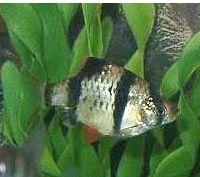Barb - Golden Tiger
Scientific Name: Barbus tetrazona
Thu, 10th July, 2025 - 12:25 am GMT
Sponsor Ads:

Alternative Name
Scientific Name: Barbus tetrazonaBasic Info
The Golden Tiger Barb is a relatively small fish. It will only reach a size of two to three inches at maturity. Golden Tiger Barbs have vertical orange and black stripes on their bodies, which resemble tiger stripes. This is where their name originates. Males, however, will have more of a redder than orange tint, especially in the nose and fin areas.
Health
Golden Tiger Barbs do not require any special attention and are rather hardy. They need their water to be between 68 and 79 degrees Fahrenheit. Golden Tiger Barbs do best in slightly acidic water, with a pH in the range of six to seven. They like to eat live and frozen food, such as: bloodworms, glass worms, brine shrimp, plankton, daphnia and vegetables. They will eat flake and freeze dried foods, as well. Breeding Tiger Barbs are egg layers and they prefer to lay their eggs in dark cavernous locations. Be sure that your Golden Tigers have plenty of hiding places to lay their eggs. When spawning, they will lay about 150 eggs. Live foods will help to encourage breeding.Habitat
Fresh water fishBehavior
Golden Tiger Barbs can add zest and life to any aquarium. This extremely active fish will keep an onlooker captivated for hours. They are especially pleasant when in schools of five or more. Golden Tiger Barbs are also hardy and easy to take care of, which makes them great for beginners, or a low maintenance tank. Don't let the name Tiger Barb fool you. They are not a very aggressive fish. Golden Tiger Barbs get their name from their body coloration. They can get a little aggressive if not kept in schools. Also, Tiger Barbs might nip at other, less active fish, such as Angle Fish. Golden Tigers enjoy plenty of space and decorations such as driftwood and rocks. They will not bother live plants.Origin
IndonesiaHistory
Golden Tiger Barbs, or the Barbus tetrazona, are originally from Borneo, Indonesia.Common Foods
N/ASponsor Ads:
complex pick-up line: If I were to ask you for sex, would your answer be the same as the answer to this question?
Barb - Golden Tiger
Coded by: BGID® | ALL RIGHTS RESERVED Copyright © 2000-2025
Disclaimer | Privacy | Report Errors / Contact | Credits








 Why haven't we as a collective earth met with aliens yet?
Why haven't we as a collective earth met with aliens yet?  World EcoSystem - Biodiversity Changes - Who is on board and who isn
World EcoSystem - Biodiversity Changes - Who is on board and who isn  Homosexual behavior stems from the mind or genetics?
Homosexual behavior stems from the mind or genetics?  The Best Text Adventure You Will Ever Play! The official site:
The Best Text Adventure You Will Ever Play! The official site:  Mouthwash - Mouthrinse - Mouth Sores - Healing Infections - Gingivitis
Mouthwash - Mouthrinse - Mouth Sores - Healing Infections - Gingivitis  Treatment for Depression
Treatment for Depression  Ultra radical and violent Islamist group that even rivals Al Qaeda
Ultra radical and violent Islamist group that even rivals Al Qaeda  An idea to have teachers who want to carry guns to school undergo some level of police training will be left up to local school districts and police departments.
An idea to have teachers who want to carry guns to school undergo some level of police training will be left up to local school districts and police departments.